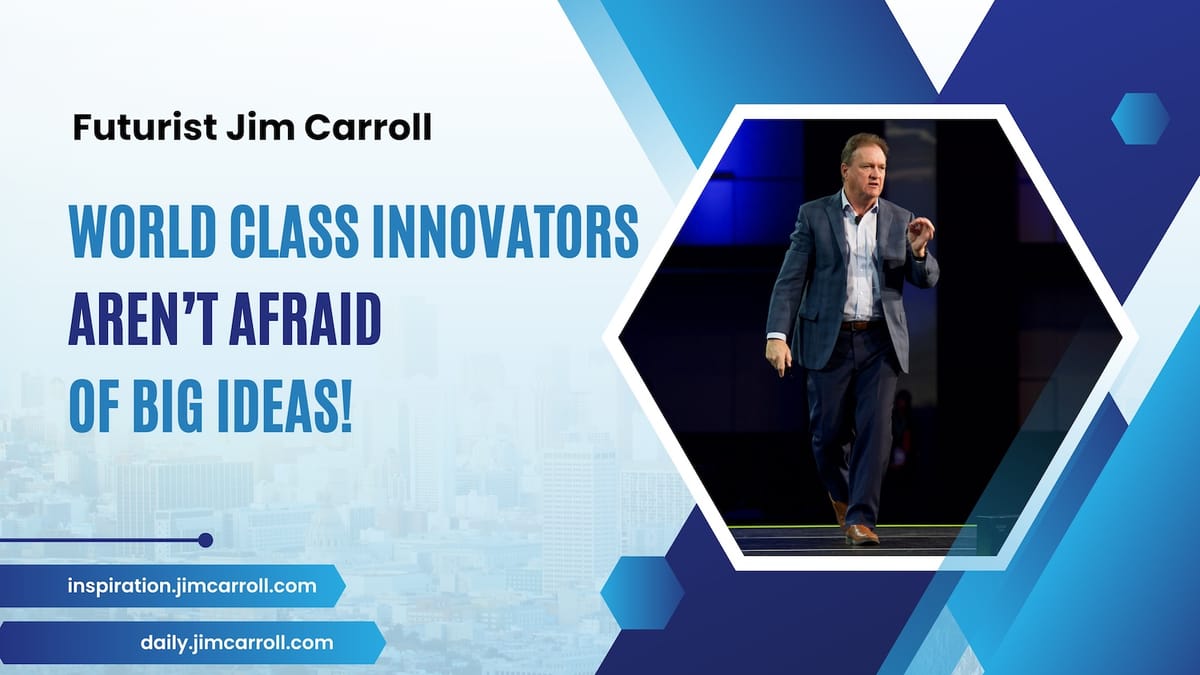"World class aren't afraid of big ideas!" - Futurist Jim Carroll
Futurist Jim Carroll is running his Daily Inspiration series for March 11/18 on the theme of “What is it that World Class Innovators Do That Others Don’t Do?” The leadership ideas are based on an original keynote he gave early in 2009 after a client asked him to identify these issues. He developed this carefully curated list based on 15 years of observations of how his global clients responded to fast-paced change.
Being bold matters.
Being bolder matters more!
The era of 'moonshot thinking' and 'moonshot innovation' envelopes the mindset of world-class innovators. When I was compiling my list of what world-class innovators do that others don't do, it was evident that it didn't just inhabit their minds - it was fundamental to everything they do.
What is moonshot innovation? It's the philosophy and approach to innovation that focuses on achieving radical breakthroughs and innovations, rather than just making small steps. The term "moonshot," of course, originates from the ambitious scale of the Apollo 11 mission, which successfully landed the first humans on the Moon—a feat that seemed almost impossible at the time. Moonshot innovation involves ambitious goals, thinking about big opportunities with radical ideas, within available and yet-to-exist breakthrough technologies and materials - in other words, chasing the impossible to make it possible.
After the dot.com collapse of 2000-2001, many people soured on the potential and promise of technology, connectivity, and the future - a sour mindset was pervasive, negativity was persistent, and small minds returned to doing small things. Not so for moonshot thinkers - the following years saw one of the biggest bursts of innovative thinking of all time.
Much of it involved 'moonshots' with big goals and big ambitions. The Human Genome Project took on the effort of mapping the entire of human genome, with the big goal of accelerating new medical discoveries and eradicating disease. The Tesla concept emerged, foreshadowing the world of electric vehicles and autonomy. Space was being commercialized with the goals of tourism, manufacturing, and new communication methodologies in mind. CRISPR gene editing, artificial intelligence, brain-computer interface technology - no idea or field of endeavor was too crazy or far-reaching to pursue.
Among some of these efforts was the X-Prize Foundation, a group that established the role of challenging the global scientific community of our time to solve some of the biggest problems of our time having to do with healthcare, the environment, education, and energy. In that context, I started telling the story on stage of George Jeston, Spock, and the Scanadu Scout - a medical tricorder of the 23rd century available to our world of the 21st century.
The key lesson in all of this? Moonshots matter. Bold thinking is everything. Big bets are necessary.
With the identification of 'big ideas' as a key part of my 'world-class innovation' list, I was finally able to identify my key guidance for organizations to go forward by pulling together the various ideas in my list. Bringing it all together, it was obvious that they needed to think big, start small, and scale fast!
The list of world-class innovations became so engrained in my thinking and was presented so often to audiences eager for the insight, that I can rattle off the list at the drop of a hat. One day, just after stage check for a major Microsoft event where I was due to speak, I did a 4-minute rant that brought together all of the key points in one summary clip.
Going forward into the future? You'll never get there by being small - it's all about trying to be bigger in your ideas, actions, and imagination than you think you might ever be able to be!
Today, the list of world-class innovation leadership thinking can be found at https://worldclassinnovation.jimcarroll.com. It remains one of the most powerful overviews of innovation in the world today and has been the focus of several hundred keynote presentations by Jim.

